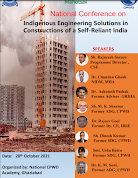A no-code development for Construction Billing was earlier demonstrated. The data model was restricted to the consolidation of Excel Billing files and an excel file containing theoretical consumptions of various basic inputs.
The technique frees us from the tyranny of
long looped Lookup formulas, the limitations of sheet rows, and how it slowed down the computer system.
However, Power Query's data extraction is not restricted to merely Excel files and folders. Here lies the opportunity to integrate the evolutionary knowledge of sustainability into construction practices and research.
In the current illustrative solution, a relevant table in the updated ECBC code, freely available on the BEE website, has been converted into a sort of App in just one sitting...and typing no code.
You can download the Excel file
here and the presentation showing the stepwise development of the table into a lookup-like app
here. The application uses Power Query and your version of Excel needs to support it.
The results may not seem specifically useful as one can always manually look up the parametric value from the table. But, here lies the difference, a lot of empirical knowledge is available and unusable/unused if it is not available in the functional digital format. Thus, the value of automating the lookup goes beyond. For example, while considering an optimal shading for a given/flexible orientation one would like to explore various permutations and combinations of shadings and orientations.
It is exciting what low code no code shift can do to a simple spreadsheet. That it was done in a single short sitting by a senior citizen is a testimony to the revolution.
What does it mean to the construction Industry? Freedom from costly and rigid construction workflow applications
☺. Maximum productivity, and low construction costs even for small construction companies.
No code with yet another growing field of cheap IoT sensor data heralds a new age for Building Research. The only limitations are imagining what and how to measure and envisioning the parameters to be optimised.
Sustainable solutions require local integrative solutions. The transparent and affordable tools have arrived. One may argue that such reductionist solutions were already available. Yes, these were, but in the form of costly proprietary software. Mostly black boxes require a learning curve and thus virtually not available to small organisations and at small scales. Low and No Code now makes the software magic accessible to all. Rapid learnability, adaptability and flexibility are an advantage over propriety black boxes.
Climate change issues related to anthropogenic carbon accumulation and overstretching of other earth systems are global. The solutions are essentially local. Niti Aayog has recently published "The Indian Model for SDG localisation". Such tools would enable local sustainability practices to redefine our fight toward net zero.
The No code technology would also be a boon to the localisation of our disaster preparedness efforts.




Comments
Post a Comment